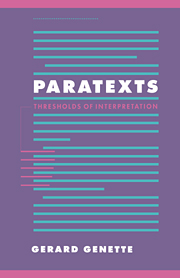Book contents
- Frontmatter
- Contents
- Foreword
- List of books by Gérard Genette
- Translator's note
- 1 Introduction
- 2 The publisher's peritext
- 3 The name of the author
- 4 Titles
- 5 The please-insert
- 6 Dedications and inscriptions
- 7 Epigraphs
- 8 The prefatorial situation of communication
- 9 The functions of the original preface
- 10 Other prefaces, other functions
- 11 Intertitles
- 12 Notes
- 13 The public epitext
- 14 The private epitext
- 15 Conclusion
- Additional references
- Index
9 - The functions of the original preface
Published online by Cambridge University Press: 04 November 2009
- Frontmatter
- Contents
- Foreword
- List of books by Gérard Genette
- Translator's note
- 1 Introduction
- 2 The publisher's peritext
- 3 The name of the author
- 4 Titles
- 5 The please-insert
- 6 Dedications and inscriptions
- 7 Epigraphs
- 8 The prefatorial situation of communication
- 9 The functions of the original preface
- 10 Other prefaces, other functions
- 11 Intertitles
- 12 Notes
- 13 The public epitext
- 14 The private epitext
- 15 Conclusion
- Additional references
- Index
Summary
“But what do prefaces actually do?” This diabolically simple question is what we will now try to answer. A preliminary inquiry, whose meanderings and hesitations I will spare the reader, has convinced me of this (highly foreseeable) point, that not all prefaces “do” the same thing – in other words, the functions of prefaces differ depending on the type of preface. These functional types seem to me for the most part determined jointly by considerations of place, time, and the nature of the sender. If we take as our base the chart of types of senders (type of sender remains the fundamental distinction) and make adjustments according to the parameters of place and time, we get a new and strictly functional typology divided into six fundamental types. Our cell A, which I have already said is the most heavily populated, will all by itself give us the first four functional types: (1) the original authorial preface (authorial is to be understood, henceforth, as meaning authentic and assumptive); (2) the original authorial postface; (3) the later authorial preface (or postface: at this stage, the distinction between preface or and postface is hardly relevant); (4) the delayed authorial preface or postface. Cell B and, very secondarily, cell C give us functional type five: the authentic allographic (and actorial) preface (the preface-writer–character is little more than a variant of the allographic preface-writer). All the other cells (A, D, E, F, and, for the principle of the thing, G, H, and I) merge, except for some slight differences, to constitute the sixth and last functional type: fictional prefaces.
- Type
- Chapter
- Information
- ParatextsThresholds of Interpretation, pp. 196 - 236Publisher: Cambridge University PressPrint publication year: 1997



